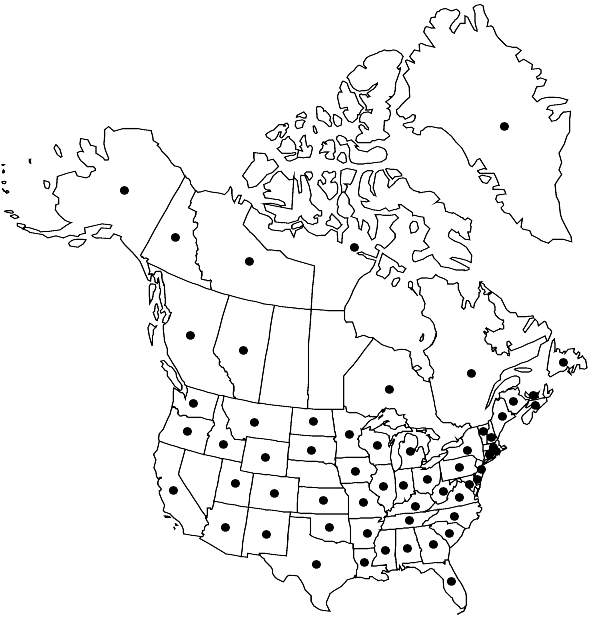Fissidens bryoides
Sp. Musc. Frond., 153. 1801,.
Plants 3–11 × 0.9–3.2 mm. Stem unbranched and branched; axillary hyaline nodules absent; central strand usually present. Leaves as many as 20 pairs, lanceolate to oblong-lanceolate or oblong-lingulate, acute to short-acuminate or obtuse-apiculate, to 0.8–2.7 × 0.2–0.5 mm; dorsal lamina narrowed proximally, ending at or before insertion, infrequently slightly decurrent; vaginant laminae 1/2 leaf length, mostly equal; margin entire but often serrulate distally, limbate on all laminae, limbidium reaching apex or ending a few cells before or partially absent to infrequently completely absent, limbidial cells 1–3-stratose; costa excurrent to ending as many as 6 cells before apex, bryoides-type; laminal cells 1-stratose, distinct, smooth, often slightly bulging, firm-walled, irregularly hexagonal, a few elongate, 6.5–16 µm, somewhat larger in proximal parts of vaginant laminae. Sexual condition polyoicous; naked antheridia and archegonia often in axils of distal leaves. Sporophytes 1–2 per perichaetium. Seta 1.4–10 mm. Capsule theca exserted, erect, radially symmetric to ± inclined, bilaterally symmetic, 0.2–1.2 mm; peristome bryoides-type; operculum 0.5 mm. Calyptra cucullate smooth, to 0.5 mm. Spores 10–20 µm.
Habitat: Soil in moist, shaded sites, stones and rocks (both acidic and basic) in shaded areas, along streams, sometimes inundated, infrequently around bases of trees
Distribution

Greenland, Alta., B.C., N.B., Nfld. and Labr. (Nfld.), N.W.T., N.S., Nunavut, Ont., P.E.I., Que., Yukon, Ala., Alaska, Ariz., Ark., Calif., Colo., Conn., Del., Fla., Ga., Idaho, Ill., Ind., Iowa, Kans., Ky., La., Maine, Md., Mass., Mich., Minn., Miss., Mo., Mont., N.H., N.J., N.Mex., N.Y., N.C., N.Dak., Ohio, Okla., Oreg., Pa., R.I., S.C., S.D, Tenn., Tex., Utah, Vt., Va., Wash., W.Va., Wis., Wyo., Mexico, West Indies, Central America, South America, Europe, Asia
Discussion
Fissidens bryoides is a veritable kaleidoscope of intergrading expressions. At one extreme is F. bryoides in the strict sense, with plants gonioautoicous and the limbidium, 1–3 cells thick, confluent at the leaf apex with the percurrent to short-excurrent costa. At the other extreme is the expression that has been singled out as F. exiguus, with plants rhizautoicous and the 1-stratose limbidium usually restricted to the vaginant laminae of perichaetial leaves. In rare cases the limbidium can be absent from all leaves. All expressions, however, have clear, distinct, 1-stratose, irregularly hexagonal laminal cells, 6.5–16 µm, that in transverse section are no deeper than wide, and that have smooth walls that can be slightly bulging. H. A. Crum and L. E. Anderson (1981) illustrated the major expressions found in the flora area. Axillary, multicellular gemmae have been reported in Indian specimens.
Selected References
None.
Lower Taxa
No values specified."/2" is not declared as a valid unit of measurement for this property.